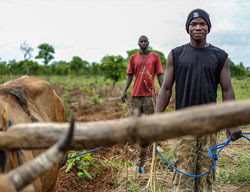 |
| Farmers attending their livestock in Northern Ghana (2012) by Ericsson Images / Flickr |
By Rachael Taylor, PhD student
SPRU, University of Sussex
Earlier this month, a number of Members of the Ghanaian Parliament presented a statement to the House calling for large investment in irrigation systems throughout Ghana. They advocate the use of irrigation for crop production as the “only way” to ensure national food security. The statement proposes that irrigation would be particularly beneficial for semi-arid Northern Ghana by enabling year-round crop production in a region which only has one wet season and currently depends predominantly on rain-fed agriculture.
The desire to take steps towards more food security in Northern Ghana is understandable. Six percent of the land area of Ghana is currently under irrigation, mostly drawn from small dam and reservoir systems, but in the three regions of Northern Ghana this figure is just 0.6 percent. Over 80 percent of households in Northern Ghana depend on agriculture as their main livelihood, making the population vulnerable to climatic shocks.
There are large socio-economic differences between north and south. Statistics indicate higher levels of poverty (63% in the north and 20% in the south), lower education attainment and literacy levels, and lower access to energy and sanitation infrastructure in the north.
In 2012 the United Nations World Food Programme (WFP) completed a Comprehensive Food Security and Vulnerability Analysis in Ghana, focusing on the northern regions. The WFP analysis identified that 16 percent of households in the three northern regions are moderately or severely food insecure, representing over 680,000 people. It will take a great effort to ensure food security for the many smallholder farmers living in poor rural areas of Northern Ghana.
The poorest may miss out
The benefits of irrigation are not evenly spread, however. There is good reason to think that investing in irrigation alone will not achieve food security for the most vulnerable households in the three northern regions. Experience has shown that wealthier farmers with higher educational attainment are most likely to obtain access to land within irrigation development programmes. Few farmers were compensated for displacement during the construction of the Tono Irrigation Dam near Navrongo in Upper East Region[1]. Furthermore, the companies responsible for irrigation development require rent-payments for land serviced by the irrigation system, excluding the poorest farmers.
Though it may be appropriate to expand the national irrigation system in Ghana, this will not increase food security and reduce vulnerability to climatic shocks for the majority of farmers in the north. Irrigation alone will not provide a secure food source for the whole population and it would be potentially damaging to invest in irrigation as the only means for achieving this. Not only will irrigation be inaccessible to the poorest and most vulnerable households, but it will detract resources (land, time, money) from the multiple diverse livelihoods that smallholder farmers in Northern Ghana depend upon.
Farmer innovations – another vital part of the solution
Farmers in the northern regions typically practice multiple livelihoods, a strategy which allows them to adapt somewhat to the annual variability of the wet season. Diversity within agricultural production is increasingly being advocated to provide options to adapt to climatic changes[2]. Through increasing diversity, enhancing adaptive capacity, and encouraging adaptive governance, rural farming communities will be better able to respond to climate variability and uncertainty. This will consequently increase food security for rural farmers – including those without access to irrigation systems.
Aside from irrigation, the Ministry of Food and Agriculture (MoFA) and the national agricultural research system of eight Research Institutes must recognise farmer innovations. Through experimentation, poor rural farmers can diversify their options, develop locally appropriate practices, and enhance their adaptive capacity without the need to invest scarce finances. This kind of experimentation should be encouraged by MoFA, alongside any improvements in irrigation provision.
Ghana has the potential to achieve nation-wide food security, but only through a combination of approaches which include those that are accessible to poor smallholder farmers in the north. Developing irrigation systems is only part of the solution. The government must broaden its efforts to include farmer innovations, alongside outputs from the eight national agricultural research institutes. Of course, physical infrastructure is important, but there is a need to recognise the importance of farmer-based adaptive capacity as a crucial element of achieving food security among the most vulnerable.
References:[1] Burayidi, M.A. (1996) Maximising Irrigation’s Contribution to Sustainable Development in Africa: Lessons from the Tono Irrigation Scheme in Ghana, In: James, V.U. (Ed) (1996) Sustainable Development in Third World Countries: Applied and Theoretical Perspectives, Praeger Publishers, Westport, CT, pp44-61
[2] Speranza, C.I. (2013) Buffer capacity: capturing a dimension of resilience to climate change in African smallholder agriculture, Regional Environmental Change, 13(3), 521-535. Available online (pdf)
This article was originally posted on the The Crossing.
Comments are closed.